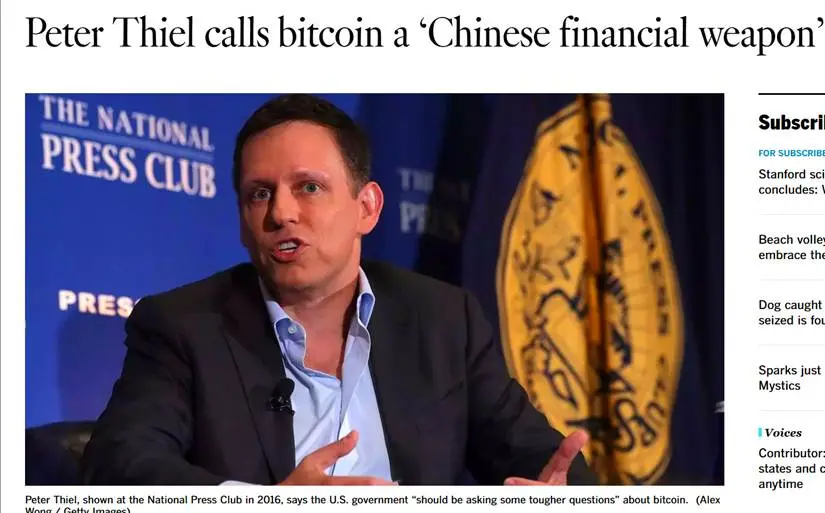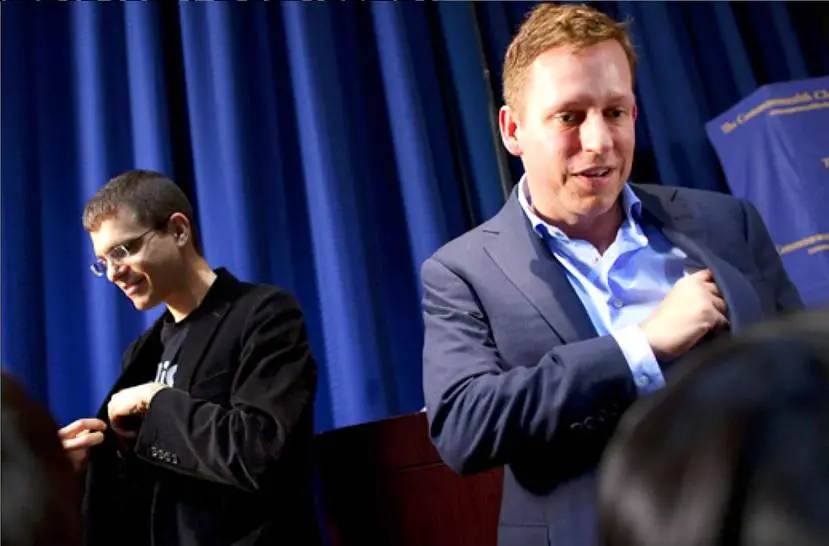In July 2025, an SEC filing sent shockwaves through the crypto community: Peter Thiel’s entity quietly acquired a 9.1% stake in BitMine Immersion Technologies, becoming the largest investor in this Ethereum treasury. Upon the news, BitMine’s stock price surged sharply, reaching a high of 29.3% during trading.
The X platform was abuzz: The PayPal godfather had finally set his sights on Ethereum—had Peter Thiel shifted his focus from Bitcoin? Was he aiming to replicate MicroStrategy’s strategy?
The market’s turmoil is not without reason. Just a year ago, Peter Thiel publicly questioned Bitcoin: “We already have ETFs; I wonder who else would buy it.” With institutional investors already in the game, who could drive the next wave? From Bitcoin to heavily investing in Ethereum, what is this Silicon Valley billionaire’s true strategy?
The ambition behind holding $1 billion worth of ETH
BitMine’s ambition is no secret: to become the Ethereum version of MicroStrategy. On July 14, 2025, BitMine held $500 million worth of Ethereum (163,142 ETH). Three days later, that number doubled to $1 billion, with 300,657 ETH. Even in the crypto world, this accumulation pace is nothing short of疯狂.
But Peter Thiel’s vision extends far beyond another corporate treasury. In 2023, a move by Founders Fund revealed his investment strategy: investing $200 million in Bitcoin and Ethereum, split evenly between the two. This allocation alone signals that Ethereum has now reached parity with Bitcoin.
Beyond BitMine’s bold move, Peter Thiel’s布局 in the Ethereum ecosystem has already been quietly unfolding:
Trading infrastructure: In 2021, he invested in the Bullish exchange, with Peter Thiel serving as a senior advisor.
Compliance infrastructure: In 2024, he invested in Paxos (a regulated stablecoin issuer), and in 2025, he continued to ramp up his investment, participating in Ubyx, aiming to become the Visa of the stablecoin sector.
DeFi infrastructure: In June 2025, he led the investment in Avantis, focusing on on-chain derivatives.
Layer-2 scaling: Invested in Caldera. As mainnet gas fees remain high, Layer-2 is the key to making DeFi truly usable.
Bitcoin is digital gold, and Ethereum is the new financial market. An investor close to Founders Fund revealed that holding Bitcoin is sufficient for value storage. However, to control the future financial infrastructure, you need Ethereum.
This assessment is well-founded. While Bitcoin is still debating its role as a store of value versus a payment method, Ethereum has already become: the main battlefield for DeFi (with over $100 billion in locked value), the preferred platform for stablecoins (USDT and USDC primarily circulate on Ethereum), and the foundational layer for the tokenization of RWA (real-world assets).
More importantly, Ethereum can generate interest. This is something Bitcoin cannot do. BitMine’s Ethereum vault strategy targets this very point, enabling assets to generate cash flow.
Peter Thiel’s ambitions extend further: Bullish Exchange has secretly filed for an IPO (June 2025), supports the creation of Erebor Bank—a specialized bank for crypto businesses (planned to hold stablecoins)—and seeks to control industry influence through CoinDesk. The picture is clear: he is no longer content with holding assets but seeks to control the channels through which assets flow.
The proportion of Ethereum ecosystem assets in Founders Fund’s blockchain investment portfolio is also gradually increasing. If the period from 2014 to 2022 was Peter Thiel’s Bitcoin era, focused on value storage and ideological narratives, then after 2023, he has officially entered the Ethereum era, building practical financial infrastructure.
Bitcoin won the ideological war, but Ethereum will win the battle for practical applications. When central bank digital currencies, corporate stablecoins, and tokenized securities become reality, they will all run on Ethereum.
Peter Thiel holds BitMine shares through various entities, not just as an investment but as preparation for control. If BitMine becomes the largest corporate Ethereum holder, Peter Thiel effectively becomes the shadow central bank of the Ethereum ecosystem. From PayPal to Bitcoin to Ethereum, Peter Thiel’s vision for a financial empire has remained unchanged, though the tools have evolved.
The dominant Founders Fund began accumulating Bitcoin when it was at $1,000
When Bitcoin was still hovering around $1,000, Founders Fund had already begun accumulating it. According to insiders, the initial investment reached tens of millions of dollars, which was considered aggressive among institutional investors at the time.
But Peter Thiel’s ambitions didn’t stop there. In 2013, he invested in Block.one (which later developed EOS). Although EOS ultimately failed to challenge Ethereum, this investment revealed his true intentions: he wasn’t after Bitcoin itself, but the next Bitcoin.
What’s even more intriguing is his strategic approach:
Mining: Investing in BitMine in 2025 was just the latest move. As early as 2018, he participated in Layer1’s funding round.
Trading: Before Bullish, he was an early investor in Kraken. Compared to Coinbase’s compliant approach, Kraken maintains a more crypto-punk style, which is very Peter Thiel.
Infrastructure: In 2021, while everyone was chasing DeFi tokens, Founders Fund quietly invested in Voltage, providing infrastructure for the Bitcoin Lightning Network.
Peter Thiel’s understanding of Bitcoin goes far beyond the concept of digital gold. In April 2021, during a conversation with former Secretary of State Pompeo, he raised the idea that Bitcoin could be a financial weapon China uses to weaken the US dollar.

The crypto community was abuzz. Supporters called him a traitor, while opponents labeled him a conspiracy theorist. However, when viewed within the broader framework of Peter Thiel’s ideological system, the logic becomes clear: Bitcoin is not merely an investment asset but a geopolitical tool capable of securing a strategic advantage in the new financial wars.
Interestingly, just one year later, he shifted his tone at the Bitcoin Conference, describing it as a revolutionary weapon against the entrenched financial establishment. He even listed his enemies: Warren Buffett, Larry Fink of BlackRock, and Jamie Dimon of JPMorgan Chase.
When addressing conservatives, he spoke of national security. When addressing the crypto community, he spoke of a freedom revolution. The core objective remained unchanged: to drive a new order independent of the traditional financial system. This precisely highlights Peter Thiel’s core trait: using narrative as a weapon.
The results were significant: he liquidated his holdings before the 2022 crypto winter, profiting $1.8 billion; in 2023, when Bitcoin dropped to $30,000, he acted again, buying $100 million worth. Textbook-level high-selling and low-buying.
An intriguing detail: in July 2024, when Bitcoin ETFs were launched and institutional funds poured in, Peter Thiel publicly stated he was unsure it would see significant gains from here. The true weapon will never be an ETF that everyone can buy.
Behind all these moves lies an unfulfilled monetary dream.
Looking at Founders Fund’s investment portfolio, the pattern is clear: it rarely invests in DApps, avoids GameFi, and only dabbles in NFTs. What truly interests it are: Layer 2 scaling solutions (Caldera), compliant infrastructure (Paxos), derivatives protocols (Avantis), and stablecoin networks (Ubyx). Protocols over products—this is Peter Thiel’s creed.
Back in 1998, when 23-year-old Peter Thiel and Max Levchin founded PayPal, what was their original vision? It wasn’t to create a payment tool, but to invent a new form of currency.

As early as a decade before the birth of Bitcoin, Peter Thiel was already contemplating how to disrupt the monetary system. In its early days, PayPal even developed a PalmPilot app that could transmit digital cash via infrared. Ultimately, due to regulatory pressure, it had to transition into a traditional payment company.
In 2002, eBay acquired PayPal for $1.5 billion. After cashing out, Peter Thiel’s first move was to establish Clarium Capital, systematically seeking the next opportunity for a monetary revolution. He waited 12 years.
In 2014, when Peter Thiel first seriously studied Bitcoin, he saw not electronic cash but PayPal’s unfulfilled dream. We live in a world where bits are unregulated while atoms are regulated. In 2015, Peter Thiel summarized it this way. The underlying message was: In the digital world, you can build anything, including an entirely new financial system.
In “Zero to One,” Peter Thiel repeatedly emphasized: Competition is a loser’s game; monopolies yield excess profits. PayPal’s experience taught him: Building a financial monopoly in the traditional world is nearly impossible. Regulation will stifle you, and big banks will surround and attack you. Cryptocurrency has changed the rules of the game.
How do you establish a monopoly in a decentralized world? The answer is: control the underlying infrastructure. When everyone is building on Ethereum, owning Ethereum is like collecting rent. When all transactions require stablecoins, controlling the stablecoin protocol is like printing money. When regulation eventually arrives, owning a compliant license is like holding the entry ticket.
Peter Thiel even funded the key figures of this revolution. In 2014, his Peter Thiel Fellowship awarded 19-year-old Vitalik Buterin $100,000, prompting him to drop out of the University of Waterloo to develop Ethereum full-time. In a sense, Peter Thiel didn’t just invest in the infrastructure; he invested in the people building it.
This explains why Peter Thiel is simultaneously investing in Erebor Bank (traditional license) and DeFi protocols (decentralized finance). Regardless of which path the future takes, he is a winner. A deeper reason may be: in his view, cryptocurrency is not PayPal 2.0, but what PayPal should have become—a truly free, globally integrated financial system unaffected by any government control.
Now, Peter Thiel’s crypto empire has taken shape
By 2025, Peter Thiel is no longer content to be a passive holder of cryptocurrency. Through BitMine, Bullish, and Erebor, he is building a complete cryptocurrency financial empire.
At this point, a question arises: why is Peter Thiel so aggressive when traditional financial giants are still watching from the sidelines? Perhaps the answer lies in his statement from 2015: “We live in a world where bits are unregulated, but atoms are regulated.”
For Peter Thiel, cryptocurrency is not just a financial revolution—it is the ultimate tool for building an unregulated world of bits. Now is the time to bet on it.
After all, as his friend and Tesla CEO Elon Musk once said: “The best adventures are calculated adventures.” In this ultimate adventure of cryptocurrency, Peter Thiel’s calculations have only just begun.
